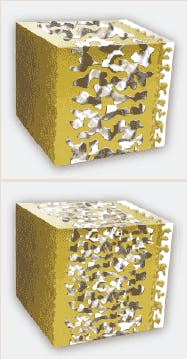Why I love and use Captek
by Michael DiTolla, DDS, FAGD
If you have been reading this column for any length of time or attended any of my lectures, you know that I still use PFMs in many clinical situations, especially Captek. There is a lot to like about Captek, and the excellent esthetics that originally drew me in is still one of the main reasons I prescribe it so often.
Also, the high gold nature appeals to me. Like many other dentists, I have always loved gold. Yet unlike traditional cast gold, there are no oxides or strength reduction due to gold content because Captek is gold internally reinforced with particles of platinum and palladium. It doesn’t hurt that this unique blend of metals has the lowest plaque retention of any material tested, including enamel.
I use Captek in areas where I would like to place an all-ceramic crown, such as lower incisors, but don’t want to do that much preparation. Because the Captek coping can be made as thin as 0.25 mm, it is a more conservative restoration than any all-ceramic crown and a good choice for smaller teeth and teeth with gingival recession.
The one limitation Captek has is its use as a bridge material. Base metals have always had the highest strength, which makes them good choices for long span bridges, but many dentists are reluctant to use them because of the possibility of patient allergies and potential legal liability. So I was excited when Captek announced that as a result of some breakthroughs in nanotechnology, they have developed a material specifically for the two most challenging areas of restorative dentistry: long span bridges and implants.
Due to enhancements of the material, indications have been broadened to long span bridges over implants and natural tooth abutments. Captek™ Bridge and Implant is specifically designed to meet the rigorous strength required for successful long span bridges and implants, which had been previously limited to conventional PFM. The added strength comes from the fact that there is twice the volume of platinum and palladium in Captek B&I, compared to traditional Captek, which results in the added strength (see figures 1 and 2). Even with this added hardness, the coping can be made as thin as 0.275 mm.
Captek B&I also has increased thermal stability which provides accuracy and predictability. Captek B&I is more tolerant to high heat, and the marginal integrity is maintained throughout firings. The density of the particles allows for tighter marginal adaptation, a harder edge and improved margin integrity, which ensures quick and easy placement over natural tooth abutments as well as long span bridges over implants.
Captek has the ability to co-exist with living tissues without causing harm. It is the only material that will not oxidize due to the high purity and high nobility content of materials used to fabricate the copings. As with traditional Captek, Captek B&I will not oxidize, which means that the tissues of the patient that come into contact with the material should not suffer from any toxic, irritating, inflammatory, or allergic reaction. It is the ideal solution to provide optimum biocompatibility, especially with implants.
Due to its higher strength, Captek B&I now allows the use of this material in situations where Captek may not have been indicated, such as cantilever bridges, bruxers or patients with difficult bites, and full arch cases.
Fortunately, Captek B&I still retains the esthetic qualities of the original material, making it a great choice for dark prep or stump shades, whether due to tetracycline or endodontic treatment. It is also a great choice for patients who want to have their PFMs replaced due to the appearance of dark metal margins at the gingival. Since there are no dark metal margins on a Captek crown, even if recession occurs, patients will not have any black lines.Dr. Michael DiTolla is the Director of Clinical Research and Education at Glidewell Laboratories in Newport Beach, Calif. He lectures nationwide on both restorative and cosmetic dentistry. Dr. DiTolla has several free clinical programs available online or on DVD at www.glidewell-lab.com. For more information on this article or his seminars, please contact him at www.drditolla.com.

